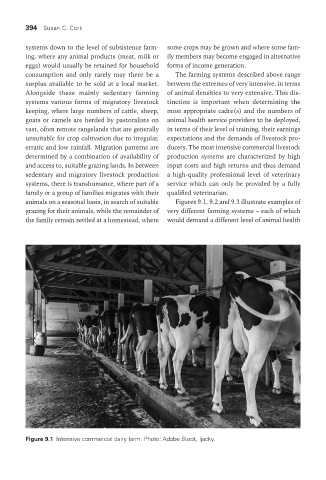Page 457 - The Veterinary Laboratory and Field Manual 3rd Edition
P. 457
394 Susan C. Cork
systems down to the level of subsistence farm- some crops may be grown and where some fam-
ing, where any animal products (meat, milk or ily members may become engaged in alternative
eggs) would usually be retained for household forms of income generation.
consumption and only rarely may there be a The farming systems described above range
surplus available to be sold at a local market. between the extremes of very intensive, in terms
Alongside these mainly sedentary farming of animal densities to very extensive. This dis-
systems various forms of migratory livestock tinction is important when determining the
keeping, where large numbers of cattle, sheep, most appropriate cadre(s) and the numbers of
goats or camels are herded by pastoralists on animal health service providers to be deployed,
vast, often remote rangelands that are generally in terms of their level of training, their earnings
unsuitable for crop cultivation due to irregular, expectations and the demands of livestock pro-
erratic and low rainfall. Migration patterns are ducers. The most intensive commercial livestock
determined by a combination of availability of production systems are characterized by high
and access to, suitable grazing lands. In between input costs and high returns and thus demand
sedentary and migratory livestock production a high-quality professional level of veterinary
systems, there is transhumance, where part of a service which can only be provided by a fully
family or a group of families migrates with their qualified veterinarian.
animals on a seasonal basis, in search of suitable Figures 9.1, 9.2 and 9.3 illustrate examples of
grazing for their animals, while the remainder of very different farming systems – each of which
the family remain settled at a homestead, where would demand a different level of animal health
Figure 9.1 Intensive commercial dairy farm. Photo: Adobe Stock, ijacky.
Vet Lab.indb 394 26/03/2019 10:26

